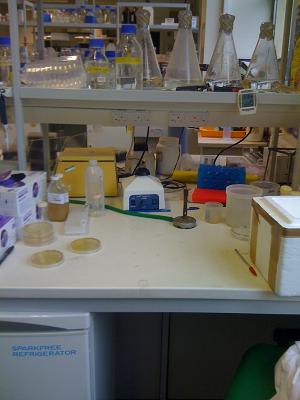Team:BCCS-Bristol/Wetlab
From 2010.igem.org
(→Wet lab) |
|||
| (34 intermediate revisions not shown) | |||
| Line 1: | Line 1: | ||
| - | + | {{:Team:BCCS-Bristol/Header}} | |
| + | =Wet lab= | ||
| - | + | <center> • [[:Team:BCCS-Bristol/Wetlab/Achievements|Achievements]] • [[:Team:BCCS-Bristol/Wetlab/Part_Design|Part Design]] • [[:Team:BCCS-Bristol/Wetlab/Experiments|Lab Work]] • | |
| + | [[:Team:BCCS-Bristol/Wetlab/Beads|Beads]] • [[:Team:BCCS-Bristol/Wetlab/Safety|Safety]] • [[:Team:BCCS-Bristol/Wetlab/Improvements|Improvements]] • </center> | ||
| - | |||
| - | + | [[Image:Picture_018.jpg|right|thumbnail|250px|Our Labspace]] | |
| - | + | Our main achievement in the wet lab has been the creation of a new composite BioBrick, engineering ''E. coli'' to produce GFP in response to Nitrates. Not only is this part complete, but it's also well characterised both on its own and working in tandem with a second BioBrick. | |
| - | + | We also developed a way of encapsulating our bacteria, allowing an easy and safe method of spreading them in the environment, and also dramatically improving signal detection and ''E. coli'' survival in soil. | |
| + | |||
| + | |||
| + | Finally we worked to further characterise the PyeaR promoter submitted by Edinburgh in 2009, improving the quality of information available in the parts registry. | ||
| + | |||
| + | |||
| + | In this section you can find out more details on all our achievements. You can also find information about about the design of our parts, including all the decisions we made and why, as well as all the information relating to their construction and characterisation. It also contains material on our new encapsulation methods, and finally lists all our safety considerations both in the lab and on a wider environmental scale. | ||
Latest revision as of 22:08, 27 October 2010
iGEM 2010
Wet lab
Our main achievement in the wet lab has been the creation of a new composite BioBrick, engineering E. coli to produce GFP in response to Nitrates. Not only is this part complete, but it's also well characterised both on its own and working in tandem with a second BioBrick.
We also developed a way of encapsulating our bacteria, allowing an easy and safe method of spreading them in the environment, and also dramatically improving signal detection and E. coli survival in soil.
Finally we worked to further characterise the PyeaR promoter submitted by Edinburgh in 2009, improving the quality of information available in the parts registry.
In this section you can find out more details on all our achievements. You can also find information about about the design of our parts, including all the decisions we made and why, as well as all the information relating to their construction and characterisation. It also contains material on our new encapsulation methods, and finally lists all our safety considerations both in the lab and on a wider environmental scale.
 "
"
